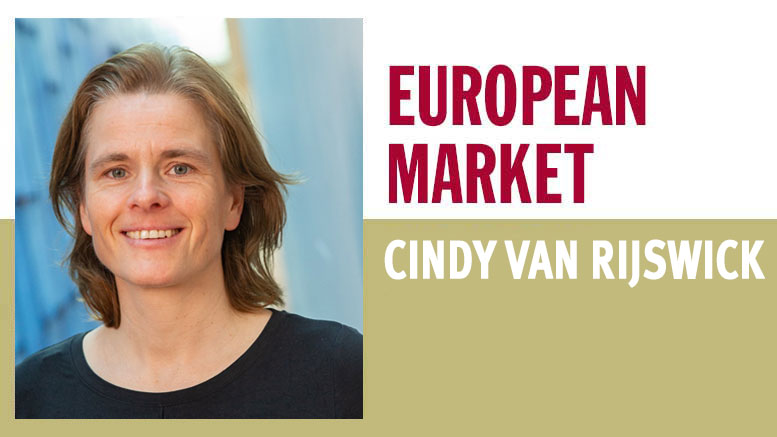EU Plans To Go Green Will Boost Innovation, But Costs Will Rise Too
July 18, 2022 | 4 min to read
The European Green Deal seeks to make the EU climate neutral by 2050, posing both challenges and opportunities for the fresh produce sector. Key proposals like the Farm to Fork Strategy aim to reduce pesticide and fertilizer use significantly, while also addressing food waste and packaging. Concerns over organic production goals and varied packaging regulations may complicate trade. Ultimately, the initiative presents opportunities for green innovation and emphasizes the essential role of fresh produce in sustainable diets.

By Cindy van Rijswick
Originally printed in the June 2022 issue of Produce Business.
Companies and citizens of the European Union (EU) will not be able to escape the fact that there is no such thing as a free lunch and there are costs to “greening” the union.
The European Green Deal is the name of the EU’s overarching policy that aims to make the EU climate neutral in 2050. Included under this roadmap are the so-called Farm to Fork (F2F) Strategy, the Biodiversity Strategy, and the Fit for 55 proposals. The extensive Green Deal package of initiatives will provide challenges, as well as opportunities, for Europe’s fresh produce sector. It will promote healthy food, such as fresh produce; encourage innovation to move to alternative energy sources and inputs; as well as add costs to the supply chain.
Important elements of the F2F strategy with a direct impact on growers include proposals to reduce the overall use of chemical pesticides by 50% by 2030. In general, there is not much debate about the ambition to reduce chemical crop production use. Growers are already implementing practices such as Integrated Pest Management (IPM) to reach many of the F2F objectives.
The availability of nonchemical alternatives is, however, a challenge. Often, these alternative products are more expensive, and processes for approval of new alternatives are lengthy. Development of new resistant varieties is time-consuming as well. New genomic techniques could speed breeding times, but gene editing is still treated as GMO (genetically modified organism) by EU regulations, and, therefore, not a solution in the foreseeable future.
Another potentially impactful F2F proposal is a 20% reduction in fertilizer use by 2030. The current record-high fertilizer prices might offer a helping hand to reach this goal. I am interested to see to what extent the current supply chain challenges encourage investments by growers in precise application technology and alternatives to synthetic fertilizers.
Proposals that target the supply chain include proposals to reduce food waste as well as packaging materials. This is already policy in some individual EU member states like France. From the start of this year, France has banned all plastic packaging for fresh fruits and vegetables, with some phasing-out time and some exceptions for delicate products like berries and mushrooms.
For internationally operating businesses, a situation of varying packaging policies within the EU is very undesirable. It conflicts with the ability to trade fruits and vegetables freely within the EU and adds additional costs. Most players in the fresh produce business are already working hard on re-using and reducing packaging materials, often by request of their retail customers. The current situation of skyrocketing packaging costs will accelerate this development.
One of the most debated F2F plans is the ambition to expand the share of the EU’s farmland in organic production from the current 8% to 25% by 2030. There is a considerable gap between existing consumer demand for organic produce and these supply-side ambitions. The organic share in overall EU food retail purchases is still below 5%, with Denmark being the front-runner with just over 12% share, according to data from IFOAM-Organics International. The 25% target is not realistic and would potentially result in plummeting prices for organic products. Wisely, in May 2022, the European Parliament voted for an amendment, saying a market-based approach should be followed and different sustainable farming models should be recognized.
The Fit for 55 plans, which include 12,000 pages of proposals, will have a more indirect impact on the fresh produce business compared to the F2F plans. The main goal is increasing energy efficiency and reducing dependence on fossil fuel. The main potential impact is, again, on the cost side in particular for energy-intensive activities and inputs, cold storage, logistics and packaging. Growers using fossil fuels to heat their glasshouses have to move toward alternatives with lower emissions. For growers in northern European countries like the Netherlands, this energy transition will be a major challenge. But again, the current high energy costs have already increased awareness this change is urgent.
A smaller challenge from the Fit for 55 plans will be the use of peat as a growing medium. Peat will become more expensive, as the proposals aim to reduce degradation of peatlands, an important natural carbon store.
The long-term question is how all of this affects the competitive position of EU businesses competing with non-EU businesses not complying with similar rules. Potentially, the EU could introduce additional import levies to create a more level playing field.
On a positive note, we should not forget about the opportunities these gigantic plans for greening can bring. The proposals will strengthen the role of the EU as fertile ground for green innovations. Demand for trees will go up in general, benefiting tree nurseries. This sector is already thriving because, increasingly, municipalities want to green their cities.
And, most importantly, the fresh fruit and vegetable sector plays a key role in a sustainable food system and healthy, sustainable diets.

Cindy van Rijswick is global strategist for fresh produce within Rabobank’s RaboResearch team. Located in the Netherlands, she has more than 20 years of research experience, mainly in fruit, vegetables and flowers.
5 of 16 article in Produce Business July 2022

